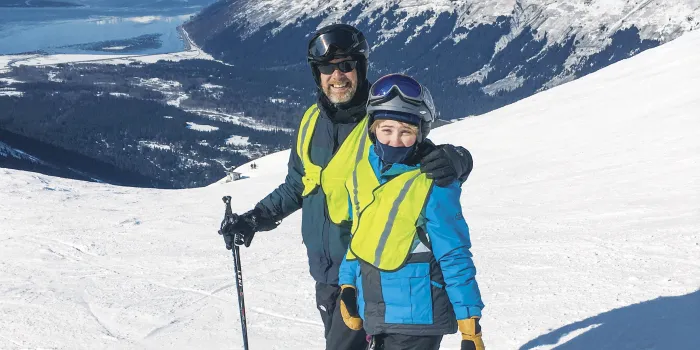Every Saturday during the winter for the past six years, 13-year-old Will and his dad, Matt Findley, have gone skiing together near their home in Anchorage, Alaska, as part of an adaptive skiing program.
What sounds like everyday fun for other sixth-graders is remarkable considering where Will has been. Will was diagnosed with severe hemophilia A (with no family history) after his newborn heel stick. At 3 months old, he had a spontaneous brain bleed that went undetected for two days. During surgery, one-fourth of his brain had to be removed. Doctors weren’t sure if Will would walk or talk. But with intense physical therapy, Will did learn how to walk, and by age 3 he also began to talk.
Will is developmentally delayed and has a seizure disorder, autism spectrum disorder and attention deficit hyperactivity disorder (ADHD).
Children with bleeding disorders who also have a developmental or neurobehavioral disability—such as ADHD or autism spectrum disorder—present numerous challenges that can feel overwhelming for families. “For example, it can be difficult for children with autism to explain things,” says Susan Zappa, RN-BC, CPN, a retired hemophilia treatment center nurse at Cook Children’s Medical Center in Fort Worth, Texas. “You try to find out what makes them comfortable, what makes them the calmest, how you can make this a routine.”
While it took Will four years of winter lessons to learn how to ski, he now skis down the hill on his own, laughing alongside his dad, just like other kids.
“He’s not OK, but he’s beyond expectations,” Findley says. “It’s more important to focus on the good things he’s doing now and try and give him the best space we can to succeed and let Will be Will.”
Four Ways to Help Your Family Thrive
Managing a bleeding disorder and another serious condition takes work. Here’s some advice to keep yourself going without burning out.
1. You know your child best.
There can be pressure to do certain things, such as teach your child to infuse. But Will Findley’s mom, Marjorie Allard, reminds parents, “You know better than anybody else what is in your child’s capabilities and what isn’t.” When Will was younger, Allard had to fight to keep him on a higher prophylaxis level than some doctors thought he needed. She pointed out to his doctors that Will had had a second spontaneous brain bleed as an infant, even though he was on prophy. Plus, his developmental delays prevented him from being able to report any falls or injuries appropriately.
2. Don’t think too far ahead.
You cannot assume your child will progress in the same way as a neurotypical child, Allard says. Instead, she and her husband encourage other parents to focus on the day to day, not stressing over “Will my child graduate high school? Will he be able to infuse himself as an adult?”
3. Take help when it’s offered—but also seek out help.
Allard and her husband, Matt Findley, went to marriage counseling to talk through issues and get advice on communication. They also did family counseling to learn better parenting skills. Allard’s mom moved from California to Alaska when Will was 1 to help out. You will always need more help than you can imagine, Allard says, so don’t be afraid to ask family and friends.
4. Get involved.
Your hemophilia treatment center and local National Hemophilia Foundation (NHF) chapter are good first starts for resources and support groups, says nurse Susan Zappa, RN-BC, CPN. “The school is also a good resource for families dealing with a diagnosis of ADHD, autism, etc.,” she says. Findley and Allard’s family is involved both in bleeding disorders groups and special needs organizations. In fact, Findley is president of the NHF Alaska chapter. The couple’s second child, Elizabeth, age 8, is a hemophilia carrier. The important thing is not to isolate your family. Seek out parents and families in similar situations so you can talk through issues.

